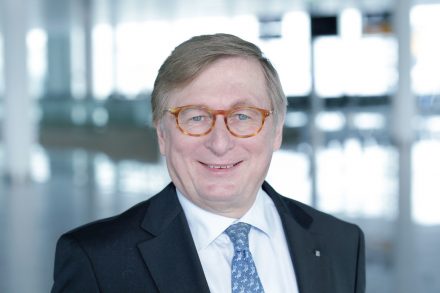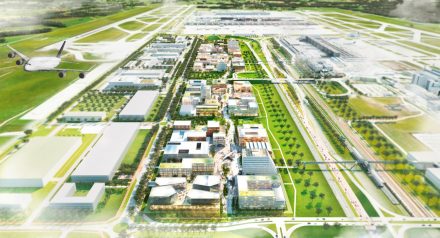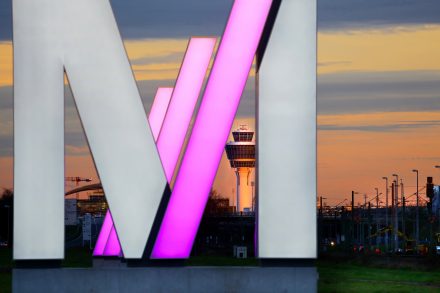Munich Airport plans to blaze new trails: With LabCampus, a cross-company and cross-industry idea center will be established on the airport campus. Why does a modern airport need to be more than “just” an airfield and transportation hub?

Airports stopped being mere traffic hubs a long time ago, and have instead turned into urban centers and meeting places. Business travelers in particular often expect to be able to hold meetings right where they land to avoid wasting time unnecessarily. For example, conferences held at airports for international experts are extremely successful, and appointments are made to meet business partners, new products are reviewed and discussions are held with specialist colleagues right at the airport.
On the side, you can discover shopping and theme-inspired areas, have a good time, meet up with friends or perhaps discuss the details of a contract over a glass of beer. At Munich Airport, it is even possible to receive medical care at our AirportClinicM.
Munich Airport has developed into a kind of “airport city” with everything you can think of, including a drug store, gas station and even a chapel and a pub. And that city is frequented by well over 100,000 travelers every day. So it is only logical for us to create a new market place that is specifically for sharing innovative ideas and to also develop a location for innovations across all industries. Munich Airport is just right for the concept and provides the ideal conditions for this kind of idea powerhouse.
What exactly is planned for LabCampus? And which partners do you already have on board for the project?
With LabCampus, an exceptional center for ideas will be established at our airport that brings together companies and experts, startups and global players, creatives and investors. We want to offer a new platform for high-tech companies and key industries in fields such as aerospace, digitalization, energy and mobility. With companies such as Siemens, Design Offices and SAP alongside research institutions like Fraunhofer Institute, Friedrich Alexander University Erlangen-Nuremberg or TU Munich’s UnternehmerTUM, we already have important partners on board as future users of LabCampus. We want to provide a space for creativity and bring together innovative experts. As the airport, we will take on the role of the curator.
It turns the entire airport into a laboratory
Startups also play a role in plans for LabCampus. How significant do you find startups in the aerospace industry? In which fields are they of particular importance?
The aerospace industry has always been exceptionally innovative and advanced. Airports are both a driving force and user of the latest technologies. So it comes as no surprise that ideas from creative individuals are in particular demand at airports. Because we lay claim to always being on the front line of technological developments, it is also important to us that our processes are state-of-the-art.
Startups can be of help in developing particularly innovative solutions that we immediately test under real life conditions. It turns the entire airport into a laboratory. After a successful test run, applications specifically for airports can be prepared for the market and implemented at other airports as well. I see a lot of potential in the field of digitalization and in optimizing the entire transportation chain; from your front door all the way to your seat on the plane, aka “seamless travel.”

How do you plan to make a rather citycentric startup scene notice what is offered at LabCampus and to accept how far it is from Munich’s urban area?
If you offer an attractive realm for innovation, particularly in combination with distinguished experts and renowned scholars, the distance from Munich’s urban area is hardly significant. Munich Airport in itself is an “airport city.” One example is our recently launched “Information Security Hub,” which to some extent is the first building block for LabCampus. In the hub, we are working together with a number of prestigious companies to develop technology to fight cybercrime, and have replicated the airport’s entire IT set up “en miniature” to do so. The result is an extremely attractive atmosphere that offers a realistic simulation of the entire airport’s system architecture. It provides various options for simulating cyberattacks as well as defending against them.
An important signal for a future-oriented project
LabCampus will certainly continue to develop considering that we just recently gave the go-ahead to start with the first phase of construction. It can be viewed as an important signal for a future-oriented project that will become an extremely attractive innovation center, a research site where individuals both live and work that also offers entertainment and recreational activities, as well as shops, bars and cafés. We are planning a future workshop, it is a vision that we are turning into reality here at Munich airport: that is our perspective.
Collaborating with startups is nothing new for Munich Airport. Our airport Innovation Management is always interested in innovative services and products that can be quickly tested in the market and improve customer experience. Are there any cooperative efforts between Munich Airport and startups that have left a particularly lasting impression?
Our high standards of quality require us to constantly review the procedures and processes at Munich Airport. We reassess and adapt them, or look for improvements and innovative solutions. We always have the needs of our passengers and customers in mind. We are open to hearing thoughts and critique from our customers. We also receive invaluable tips and recommendations for improvements from our employees, which we also examine and implement.
We established a successful in-house idea platform known as “InnovationPilot,” which was also developed in collaboration with a startup, namely innosabi. We are also a part of the German Aviation Innovation Award and gave an award to the startup “eWings,” which developed a flight booking system based on the user’s perspective. Or think about the sleeping cabins “napcabs,” which were developed by young students and have become an established feature in Terminal 2. The perhaps most recent example is the Munich startup “styleGREEN,” which has been getting attention thanks to an installation of Iceland moss on a 505 square foot billboard. We were so excited about the idea that we purchased entire carpets of Iceland moss to advertise our “green airport” and climate protection efforts.

The “Future of Mobility” is a popular subject: Which future visions for air transportation do you find particularly interesting? What will the airport of the future look like?
The trend towards a further stage of digitalization will fundamentally change operational procedures in airports in the foreseeable future. Sensors will not only watch over fully automated systems and deliver real-time data about the operating status, but will also communicate with other interlinked control systems. Surveillance cameras with automatic facial recognition will make security checks easier. What I find particularly interesting is the idea of passengers being guided with personalized mobile devices while we give them all of the important information on their smartphones on their way to the gate. They will also receive relevant suggestions for offers at the shops or restaurants they are currently walking past.
Munich Airport climate-neutral by 2030
What passengers do once they arrive will also change significantly. In addition to effective and reliable public transportation, autonomous buses will also be in use, e-mobility will expand and car sharing will become the norm. Transportation operators will be closely linked with one another, and all costs will be booked using smartphones. That will make all processes seamless and smart.
Airports will also be increasingly green. We have already set the course for making Munich Airport climate neutral by 2030. Advanced technologies, particularly lightweight yet stable components, resource-friendly engines and alternative fuels will make flying even more energy efficient. Have you already heard about the researchers at the Netherlands Aerospace Centre developing an airport with one single, circular runway? When it comes to the future, I feel certain that we will not run out of ideas.
Thank you very much for the interview, Dr. Kerkloh!
Learn more about Munich Airport’s innovation management here.



